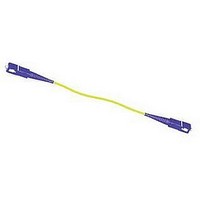942-31066-10003 AMPHENOL FIBER OPTICS, 942-31066-10003 Datasheet - Page 3

942-31066-10003
Manufacturer Part Number
942-31066-10003
Description
Fiber Optic Cable Assembly
Manufacturer
AMPHENOL FIBER OPTICS
Datasheet
1.943-31255-10001.pdf
(12 pages)
Specifications of 942-31066-10003
Fiber Diameter
9/125um
Cable Assembly Type
SC Fiber Optic
No. Of Fibers
1
Cable Length
3m
Boot Type
Standard
Connector Type B
SC Duplex
Connector Type A
SC Duplex
Fiber Type
Singlemode
Cable Diameter Max
3mm
Rohs Compliant
Yes
Lead Free Status / RoHS Status
Lead free / RoHS Compliant
In order to produce high quality, reliable cable assemblies, there are a number of physical characteristics that must be addressed. Many of
these issues have been thoroughly outlined in IEC, EIA/TIA, JIS and Telcordia standards. They include acceptable parameters for
intermateability, insertion loss, return loss, radius of curvature, apex offset and fiber height. Other issues that attribute to long term
reliability are ferrule/fiber fit, ferrule concentricity, and ferrule surface defects. The following diagrams illustrate some critical components
of a fiber optic cable assembly.
Note: Optical tuning is available for specific connectors, providing lower insertion loss ‘typicals’.
Misalignment - Fiber core alignment is critical to a cable
assembly’s ability to transmit light. Main causes of misalignment are
typical mechanical issues associated with low quality connectors or
fiber: ferrule concentricity, hole tolerances, fiber eccentricity, and
variations in core diameter.
Surface Defects - Visual defects are one of the most common
causes of latent failures. Scratches, pits, and chips in the ferrule end-
face can change over time, becoming more pronounced and migrat-
ing to critical areas of the fiber core, thus affecting
performance. They are also a prime source for deposits of dust,
moisture, and other contaminants.
Radius of Curvature - The endface of the connector is given a
specific radius during the polishing process. This radius provides the
basis for ensuring that both fibers make contact. Both the apex offset
and fiber heights are dependent on the radius of curvature being
within the predetermined parameters.
Fiber Height - Physical contact of the fiber is necessary for proper
light transfer. The end-face geometry has strict fiber protrusion limits,
as well as fiber undercut limits. These limits are based exclusively on
a mathematical calculation of the radius of curvature. If the fiber is
too high, damage to the endface may occur. If the fiber is too low,
the physical contact may never occur, causing increased attenuation
and reflectance.
Apex Offset - Physical contact connectors feature a radius on the
endface. The peak of the radius is known as the apex. The relationship
from the apex to the ‘perfect’ center of the ferrule, is known as the
apex offset. Strict control of this specification is mandatory in order to
precisely control the distance of each fiber from the surface of the
connector and to ensure physical contact upon mating.
SINGLE MODE
SC, FC, LX.5, LC & ST
MT-RJ
MPO
MULTIMODE
SC, FC, LX.5, LC, & ST
905 & 906 SMArt
MT-RJ & MPO
SMA
super (SPC)
ultra (UPC)
angle (APC)
ultra (UPC)
angle (APC)
premium angle (PAPC)
super
ceramic ferrule
stainless steel ferrule
super
IL typical
0.18dB
0.14dB
0.23dB
0.20dB
0.25dB
0.15dB
0.35dB
0.56dB
0.77dB
0.35dB
2
Height
Fiber
IL maximum
0.50dB
0.30dB
0.50dB
0.50dB
0.75dB
0.35dB
0.50dB
1.00dB
1.50dB
0.75dB
Photo not to scale. Features exaggerated.
Photo not to scale. Features exaggerated.
Conversion Chart
Apex
1 meter
1 meter
1 cm
1 cm
1 foot
1 inch
© 2001 Amphenol Corp. 9/01 Printed in U.S.A.
RL typical
apex
offset
-52dB
-61dB
-70dB
-55dB
-55dB
N/A
=
=
=
=
=
=
Customer Service 800-944-6446
sales@amphenol-fiberoptics.com
www.amphenol-fiberoptics.com
3.281 feet
39.37 inches
0.0328 feet
0.3937 inches
0.3048 meter
25.4 mm
Fiber
RL maximum
-45dB
-55dB
-65dB
-35dB
-55dB
-55dB
Radius of
Curvature














